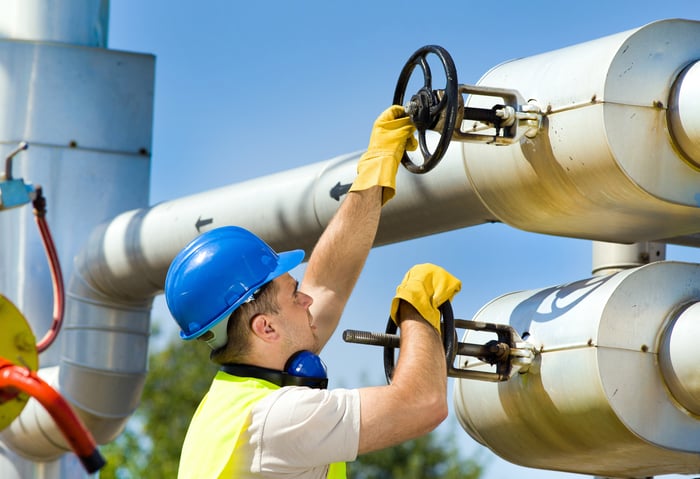Kinder Morgan (KMI 0.27%) is a bellwether midstream partnership, offering investors a generous 6.4% yield. Plains All American Pipeline (PAA 1.11%), meanwhile, has a huge 8% yield.
It's easy to get sucked in by a big yield, given that both of these companies operate in the same general industry. But there are some things to know before you buy. At the end of the day, the lower yield could be the better long-term option in this case.
Speaking of dividends
Since the midstream sector is generally known as a good place to find yield, it's a worthwhile starting point for a discussion of Kinder and Plains All American. The story, however, isn't all that great.

Image source: Getty Images.
Master limited partnership Plains All American cut its distribution in 2016 and then again in 2017, for a grand total of a 57% decline. Management was looking to mend a debt-heavy balance sheet, while shifting the business model toward growth. It increased the distribution by 20% in 2019, as it seemed to have made some progress, but cut it by another 50% in 2020 as the coronavirus pandemic upended the energy market.
Once again, a key goal was to reduce debt. The distribution is now roughly 75% below what it was at the start of 2016. If you're looking for a reliable income stock, Plains All American doesn't look like a particularly good choice.
Kinder Morgan, meanwhile, also cut its dividend in 2016. But it went in a completely different direction, with an upfront 75% reduction. Management, at a time when accessing capital markets was difficult, made the call to invest in capital spending projects at the expense of the dividend. That was partly because of a debt-heavy balance sheet, but the decision to make such a large cut actually set dividend investors up for a much more predictable future.
The dividend was increased 60% in 2018 and 25% 2019. The plan was to increase the dividend another 25% in 2020, but the pandemic got in the way. The hike was trimmed to 5%.
To be fair, Kinder Morgan had been saying it would hike the dividend by as much as 10% in 2016 just a couple of months before that first cut. And it didn't live up to its original dividend plan for 2020. For truly conservative types, there are very real trust issues that need to be considered with Kinder Morgan. But compared to Plains All American, it looks like it has done a better overall job for dividend investors.
The core of the issue
One of the problems facing Plains All American is that a good portion of its business is heavily tied to moving oil and natural gas from wells to larger long-haul transportation options. In the industry, this is known as "gathering."
With the supply/demand equation in the energy sector still fragile, it's not clear when demand for Plains All American's transportation services will pick up in a material way. That said, this business, which witnessed a 15% year-over-year decline in adjusted earnings before interest, taxes, depreciation, and amortization (EBITDA) in the fourth quarter (and a drop of 6% for the full year) held up better than the partnership's supply and logistics division, which was off by 98% in the fourth quarter (and roughly 75% for the year).

Data by YCharts.
Together, these two divisions make up the bulk of the partnership's business. Supply and logistics, notably, takes on commodity price risk, and in 2020, that was clearly not a good thing to do. It also highlights the inherent volatility in Plains All American's business and why investors hoping for a reliable dividend might want to look elsewhere.
That business alone contributed nearly a quarter of adjusted EBITDA in 2019, so it's no wonder the partnership cut the distribution when the business faltered so badly in 2020. Energy is a commodity business prone to dramatic ups and downs, and Plains All American exposes investors to that.
Kinder Morgan is a little different. Its business is largely fee-based and driven by long-term contracts for the use of its diverse asset base. Adjusted EBITDA was lower across all of the company's main business lines, with its products-pipelines division down 18% in 2020 and terminals lower by 16%. But its natural gas pipeline group, which is around four times the size of the company's next largest division, was only off by 3%.
In other words, the core of Kinder Morgan's business held up relatively well, with weakness on the edges. Even its businesses that take on commodity risk, like its CO2 operations (adjusted EBITDA down 8% in 2020), held up better than Plains All American's supply and logistics operations.
All in, Kinder Morgan looks like a less risky business, and that makes it the more desirable choice here.
What to do
In this comparison, investors looking for a reliable dividend stock will probably be better off with Kinder Morgan over Plains All American. But there are other fish in the proverbial midstream sea, so if you're looking at this pair, you might want to expand your search before making a final decision.
For example, Enterprise Products Partners and Enbridge are two other high-yield options in the sector with decades of annual increases under their belts. Most investors would probably be better off with one of them than with Kinder Morgan.





